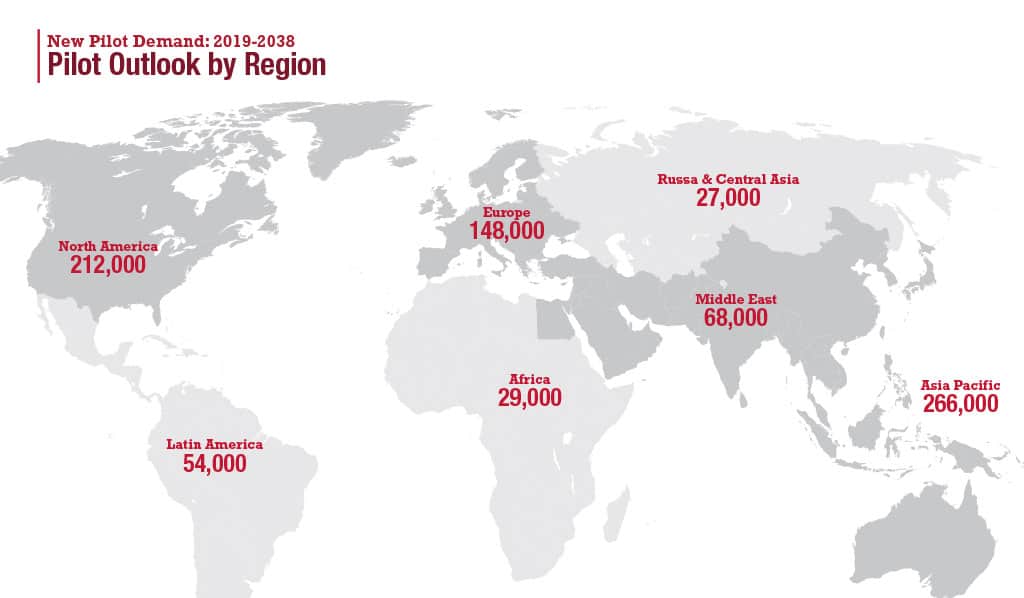Aviation Talent Shortage: The Time to Act is Now
Aviation is an industry that hires, trains and supports some of the brightest, most skilled and dedicated people working today. It has to, in order to ensure that aircraft meet all safety requirements and flight departments continue to operate efficiently and effectively. That’s why there’s growing concern about the state of the aviation talent pool.
The 2019 Boeing Pilot & Technician Outlook, which covers personnel demand in the business aviation, commercial aviation and civil helicopter industries, states that “804,000 new civil aviation pilots, 769,000 new maintenance technicians, and 914,000 new cabin crew will be needed to fly and maintain the world fleet over the next 20 years.”1 Unfortunately, companies that have historically had an ample supply of candidates for open positions are now seeing the pipeline start to dwindle. And this challenge doesn’t just involve pilots, although their numbers are dropping as well. The talent shortage affects flight crews, ground crews, scheduling and operations teams, and the vendors that support aviation.

A “Perfect Storm” is Brewing
What’s behind the decline in the talent pool? It’s a multifaceted problem, of course, and one that’s continually evolving. However, it’s clear that certain factors are coming together in a way that none of us in the industry have seen in our lifetime.
First, as the world population grows, so does the demand for aviation and the expertise it requires. Consequently, talent resources are being stretched thin. Second, numerous aviation professionals are approaching retirement age. For example, according to the U.S. Bureau of Labor Statistics, the median age of aviation mechanics is 51, which is nine years older than that of the U.S. workforce in general.2 As the individuals on the leading edge of this wave start to leave, the industry is feeling the pinch.
Third, regarding business aviation in particular, more pilots than ever are changing course and going to work for the airlines, lured by better compensation, more predictable schedules, robust retirement benefits and job stability. And finally, the number of people pursuing careers in aviation has leveled off in recent years or is even declining by some estimations.
As a result, many experts feel that the numbers have moved beyond concerning and are headed in the direction of critical. Fortunately, one factor the industry has in its favor is a growing awareness of the issue. At one point a small problem left to HR departments to wrestle with, the increasing talent shortage now has the attention of everyone from frontline workers to C-suite decision makers. This is good, as it’ll require a concerted effort to right the (air)ship!
Taking Steps to Address the Aviation Talent Shortage
What can be done to reverse the industry’s troubling downward talent trend? Surely the solution will have to be as multifaceted as the problem. Stakeholders must:
INCREASE OUTREACH EFFORTS
No doubt, the number of young people considering employment in aviation is directly related to the number of them who are exposed to aviation as a career path. So, we must all create more opportunities for young people to learn about our industry, and their exposure to the world of aviation should start as early as elementary school.
PROVIDE BETTER TRAINING
To create optimal educational environments that stimulate and challenge team members, aviation has to adopt new teaching modes and methods including immersive technologies and adaptive learning.
IMPROVE WORK/LIFE BALANCE FOR EMPLOYEES
Being on-call and ready to assist with flights taking place at any time of the day or night may have some allure for people new to the industry. But very quickly, that appeal diminishes and most employees want a more standard schedule and the stability it provides.
MATCH THE COMPENSATION OF OTHER INDUSTRIES
To maintain a healthy talent pool, business aviation specifically must provide the kind of salaries and benefits offered by the airlines and other industries that are enticing good employees to leave.
MAKE IT EASIER TO HAVE A CAREER IN AVIATION
While the requirements around training and certifications in our industry were developed for safety reasons, any aspects of them that don’t support that mission and instead discourage people from pursuing an aviation career should be considered for modification or elimination.
SUPPORT EMPLOYEES THROUGH MENTORSHIP PROGRAMMES AND OTHER INITIATIVES
One of the many appealing aspects of a career in aviation is the sense of being part of a “family.” That feeling can be enhanced through mentorship programmes that teach employees new skills but also reassure them that they have strong connections with knowledgeable peers they can turn to when they need advice or support.
What’s on the Horizon?
Aviation is a “can do” industry. Dealing with the workforce issues that we face today will be no different. We must get started now, and we will. But there’s every reason to believe that the energy and resources aviation is bringing to bear on the challenge will, before long, reverse the talent shortage and attract the enthusiastic newcomers that will be needed.
Resources
1 https://www.boeing.com/commercial/market/pilot-technician-outlook
2 https://www.atec-amt.org/news/category/workforce




